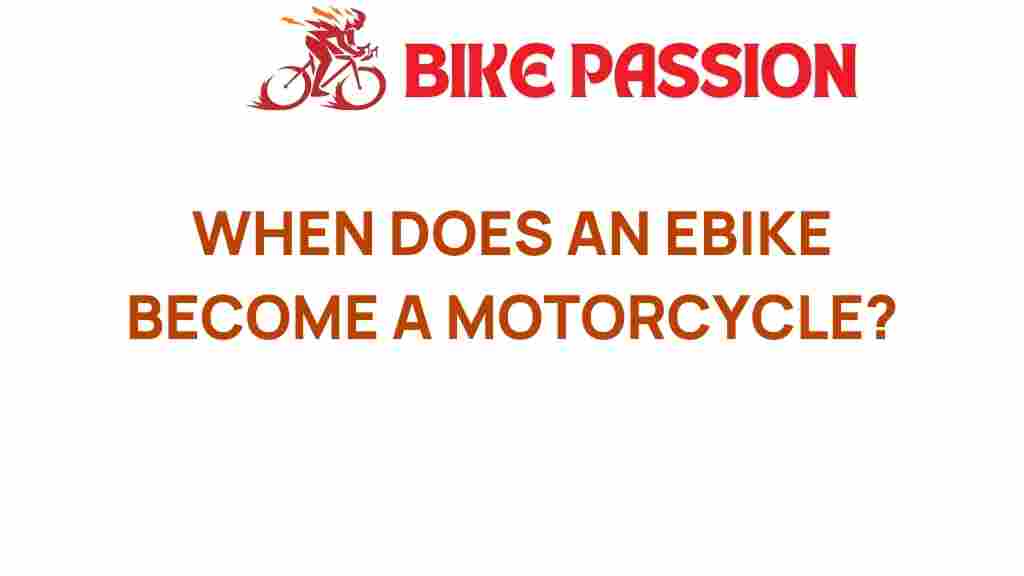When Does an E-Bike Cross the Line into Motorcycle Territory?
The rise of electric bicycles, commonly known as e-bikes, has transformed the way we think about personal transportation. These innovative vehicles combine the convenience of cycling with the power of electric motors. However, with this evolution comes a critical question: when does an e-bike cross the line into motorcycle territory? In this article, we will explore the classifications, regulations, and safety implications that differentiate e-bikes from motorcycles, helping you understand where your ride fits in.
Understanding E-Bike Classifications
E-bikes are typically categorized into three main classes based on their design and functionality:
- Class 1: Pedal-assist only, with a top speed of 20 mph. The motor only engages while the rider is pedaling.
- Class 2: Throttle-assisted, allowing riders to engage the motor without pedaling, also capped at 20 mph.
- Class 3: Pedal-assist with a top speed of 28 mph, but throttle assistance is not allowed.
These classifications are essential as they dictate the regulations that govern where and how e-bikes can be used. For instance, many areas allow Class 1 and Class 2 e-bikes on bike paths, while Class 3 may have restrictions.
Regulations Governing E-Bikes and Motorcycles
The distinction between e-bikes and motorcycles often comes down to local and state regulations. Here are some key points to consider:
- Licensing: In many regions, e-bikes do not require a motorcycle license, whereas motorcycles do. This is a major factor in classification.
- Registration: E-bikes generally do not need to be registered with the DMV, while motorcycles must be.
- Insurance: E-bike owners typically do not need motorcycle insurance, which is a requirement for motorcycle riders.
- Equipment Standards: Motorcycles must meet specific safety standards that e-bikes are exempt from, such as having headlights, turn signals, and mirrors.
Understanding these regulations is crucial for riders to avoid legal complications. Check your local laws to ensure compliance with e-bike classifications and regulations.
Performance Characteristics of E-Bikes vs. Motorcycles
The performance of an e-bike can often be a point of contention when determining if it operates more like a motorcycle:
- Speed: Most e-bikes are limited to 20-28 mph, while motorcycles can exceed 60 mph easily.
- Power Output: E-bikes typically have a motor power of 250-750 watts, whereas motorcycles can have engines ranging from 50cc to over 2000cc.
- Weight: E-bikes usually weigh between 40-70 lbs, while motorcycles can weigh over 200 lbs.
While some high-performance e-bikes might approach motorcycle speeds, the overall performance capabilities distinguish them significantly in most cases.
Technological Aspects of E-Bikes
Advancements in technology have greatly enhanced e-bike performance, safety, and user experience:
- Battery Technology: Modern e-bikes use lithium-ion batteries that offer significant range and longevity.
- Motor Technology: Brushless motors provide efficient power and smooth acceleration.
- Smart Features: Many e-bikes come with apps that track performance, route planning, and even theft protection.
These technological enhancements contribute to the appeal of e-bikes, making them a popular choice for commuting and recreational riding.
Safety Considerations for E-Bikes and Motorcycles
Safety is paramount whether you are riding an e-bike or a motorcycle. Here are some safety tips relevant to both:
- Wear a Helmet: Always wear a certified helmet to protect against head injuries.
- Be Visible: Use lights and reflective gear, especially when riding at night.
- Follow Traffic Rules: Obey all traffic signals and signs, and use bike paths where applicable.
- Maintain Your Vehicle: Regularly check your brakes, tires, and battery to ensure optimal performance.
Furthermore, while e-bikes may not require the same level of protective gear as motorcycles, investing in quality safety equipment is still essential.
Licensing and Insurance Requirements
The licensing requirements for e-bikes vary significantly from those for motorcycles:
- No License Needed: Most e-bikes do not require a license to operate, making them accessible to a broader range of users.
- Motorcycle Endorsements: Riding a motorcycle requires a motorcycle endorsement on your driver’s license, along with proof of insurance.
In some states, however, certain high-powered e-bikes may fall under motorcycle regulations, which could require licensing and insurance. Always verify your local laws to avoid legal issues.
Step-by-Step: Determining Your E-Bike’s Classification
To determine whether your e-bike crosses into motorcycle territory, follow these steps:
- Check the Motor Power: If your e-bike has a motor over 750 watts, it may be classified as a motorcycle in some areas.
- Assess the Top Speed: If your e-bike can exceed 28 mph, it is likely to fall under motorcycle regulations.
- Review Local Laws: Check your state or local regulations regarding e-bike and motorcycle classifications.
- Consult with Local Authorities: If in doubt, contact local transportation authorities for clarification.
By following these steps, you can ensure that you are riding within the legal frameworks set for e-bikes and motorcycles.
Troubleshooting Common E-Bike Issues
If you encounter problems with your e-bike, here are some common issues and their solutions:
- Battery Won’t Charge: Ensure the charger is plugged in and check for any visible damage to the battery.
- Motor Not Engaging: Check the connection between the battery and motor, and ensure the battery is fully charged.
- Punctured Tires: Regularly inspect tires for wear and replace them as necessary.
Regular maintenance can prevent many of these issues and keep your e-bike running smoothly.
Conclusion
As e-bikes continue to grow in popularity, understanding their classification compared to motorcycles becomes increasingly important. With varying regulations, performance characteristics, and safety considerations, knowing where your e-bike stands can help you navigate the complexities of legal compliance and ensure your riding experience is both enjoyable and safe. Remember to always stay informed about local laws and best practices for e-bike usage, and enjoy the ride!
For more information on electric vehicles and their regulations, visit this resource.
If you’re interested in the latest technological advancements in e-bikes, check out this informative article here.
This article is in the category Tech and created by BikePassion Team
